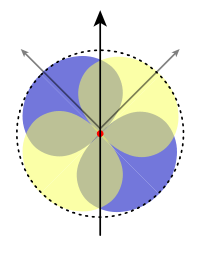Blumlein Pair
Blumlein Pair is the name for a stereo recording technique invented by Alan Blumlein for the creation of recordings that, upon replaying through headphones or loudspeakers, recreate the spatial characteristics of the recorded signal.
The pair consists of an array of two matched microphones of bi-directional (figure 8) pickup pattern, positioned 90° from each other. Ideally, the transducers should occupy the same physical space; since this cannot be achieved, the microphone capsules are placed as close to each other as physically possible, generally with one centered directly above the other. The array is oriented so that the line bisecting the angle between the two microphones points towards the sound source to be recorded (see diagram). The pickup patterns of the pair, combined with their positioning, delivers a high degree of stereo separation in the source signal as well as the room ambiance.
The Blumlein pair produces an exceptionally realistic stereo image, but the quality of recordings is highly dependent on the acoustics of the room and the size of the sound source.
Both ribbon and condenser microphones can be used for Blumlein pair recording. A few types of stereo ribbon microphones (B & O, Royer, AEA) have even been purpose-built for just this type of recording. Several types of stereo condenser microphone (Neumann, AKG, Schoeps) have also offered a Blumlein arrangement as one of their possible configurations. Individual mics with variable patterns (such as those from Pearl/Milab) can be used. The Soundfield microphone used to make Ambisonic recordings can be adjusted to mimic two microphones of any pattern at any angle to each other, including a Blumlein pair.
In his early experiments at EMI with what he called "binaural" sound, Blumlein did not use this actual technique because he did not have access to figure-8 microphones. This meant that he had to develop ways of using omnidirectional microphones to record what we now know as stereo sound. In the claims he made in his U.K. patent application in 1931, as well as details of these techniques, he included the theoretical possibility of using directional microphones in what later became known as a Blumlein Pair. During the period when Blumlein's patent (British Patent 394325) was being written, Harry F. Olson published a patent for the first practical ribbon microphone and much of the later experimental work was carried out with this type of microphone[1]
It is unclear when this approach became known as the Blumlein Pair, although it does not appear to have been known by that name during his lifetime.
The Blumlein pair microphone pattern can also be decoded from a soundfield microphone. And since a well-calibrated soundfield microphone goes down further into the bass than all but the very best directional microphones, and its coherent array performance extends to higher frequencies than the usual Blumlein Pair, a well-calibrated soundfield microphone is potentially the best performing Blumlein Pair.
 |
 |
 |
| Bidirectional (Figure 8) Microphone Sensitivity Pattern (Red dot is microphone, viewed from above) |
Blumlein Pair Array (2 crossed Figure-8s) |
Blumlein Pair Array (Small arrows indicate front of individual microphones, large arrow indicates front of array.) |
|---|
References
- ↑ Clark, H. A. M.; Dutton, G. F.; Vanderlyn, P. B. (February 1958), "The 'Stereosonic' Recording and Reproducing System: A Two-Channel Systems for Domestic Tape Records", Journal of the Audio Engineering Societyl, 6 (2): 102–117
External links
| Wikimedia Commons has media related to Blumlein pairs. |